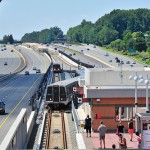Your commute feels longer because it probably is
Does it feel like your commute is getting longer? It probably is. A new study from the Brookings Metropolitan Policy Program, The Growing Distance Between People and Jobs in Metropolitan America, discovers that as people and jobs headed to the suburbs in the 2000s, the number of jobs located near the average resident dropped. And people’s proximity to jobs can impact more than simply commuters’ moods — in fact, it can affect local fiscal health as well as residents’ employment options, especially among low-income and minority workers.

Image by Stewart Butterfield.
Jobs started shifting out of city centers in the 2000’s. As Elizabeth Kneebone and Natalie Holmes, the study’s authors, point out, that decade “ushered in significant demographic and economic changes that have redrawn the map of economic opportunity in metropolitan America” — jobs declined due to two economic downturns, and jobs moved further outward within the country’s biggest metro areas. In fact, jobs shifted away from the urban center of nearly every major metro area.
People followed the shifting jobs, with the poor and minorities sub-urbanizing most quickly; by 2010, “every major ethnic and racial group and the majority of the poor lived in suburbs for the first time,” explain the authors. These two moves — of people and of jobs — changed the proximity between people and their jobs, and “often not for the better.” Why is proximity important? Most significantly, the nearness of jobs can impact the employment outcomes of residents. The closer one lives to a job, the more likely one is to work; those who live closer to jobs also have shorter employment searches and shorter periods of unemployment.
Being close to work is especially significant for certain types of residents and workers; for instance, the length of unemployment among black, female and older workers is usually more related to job accessibility than for other types of workers. And for poor workers, living closer to work boosts their chances of working and getting off welfare. Lower-income and lower-skill workers also benefit from living closer to jobs since they tend to struggle more with housing and commuting costs. Higher-income and higher-skill workers tend to be able to afford cars; commuting by car means that these higher-income workers have a greater choice in where they live and work, and more opportunities since they don’t need to restrict their job search to their immediate neighborhoods.
For this study, the authors drew up a national database of local-level demographic and private-sector employment data (private-sector jobs make up 84% of all jobs in the U.S.), as well as data from U.S. Census Bureau reports. They used census tract level data on commutes to pinpoint a typical commute distance within metro areas as well as for the non-metropolitan areas of each state. As for job proximity, they measured how many jobs were located within the typical commute distance of the center of each census tract they studied.
So, what did the researchers discover? A few key findings include:
- Jobs within the average commute distance for residents in major metro areas dropped by 7% between 2000-2012.
- Jobs located near the typical city and the suburban resident dropped as jobs moved to more suburban areas.
- As poor and minority residents moved toward the suburbs in the 2000s, their closeness to jobs fell even more so than for white and non-poor people.
- Neighborhoods with high poverty and with a majority of minority residents experienced the greatest declines in job proximity.
Community leaders and decision-makers will need to address these changes with collaborative solutions. “Crafting solutions that balance local assets, challenges, and needs with regional goals is not something that can be done piecemeal by individual municipalities or communities,” note the authors. “To foster growth that is truly regional in its reach and that does not exacerbate inequality or leave low-income and minority residents behind, communities will need to coordinate and collaborate as they plan and implement policy decisions that affect metropolitan development patterns.”
How has your commute changed? Learn more: Check out the study’s typical commute for 96 large metro areas from Akron to Winston-Salem on pages 20-21.
Related Posts
Category: Transportation

















